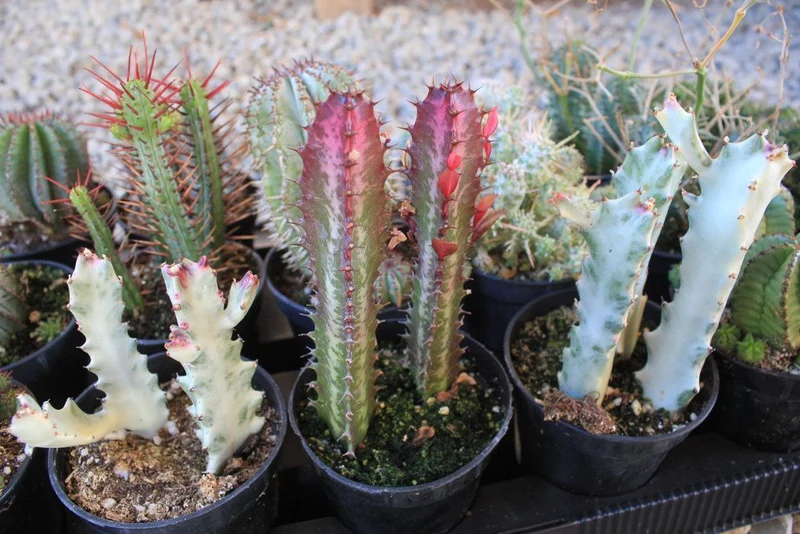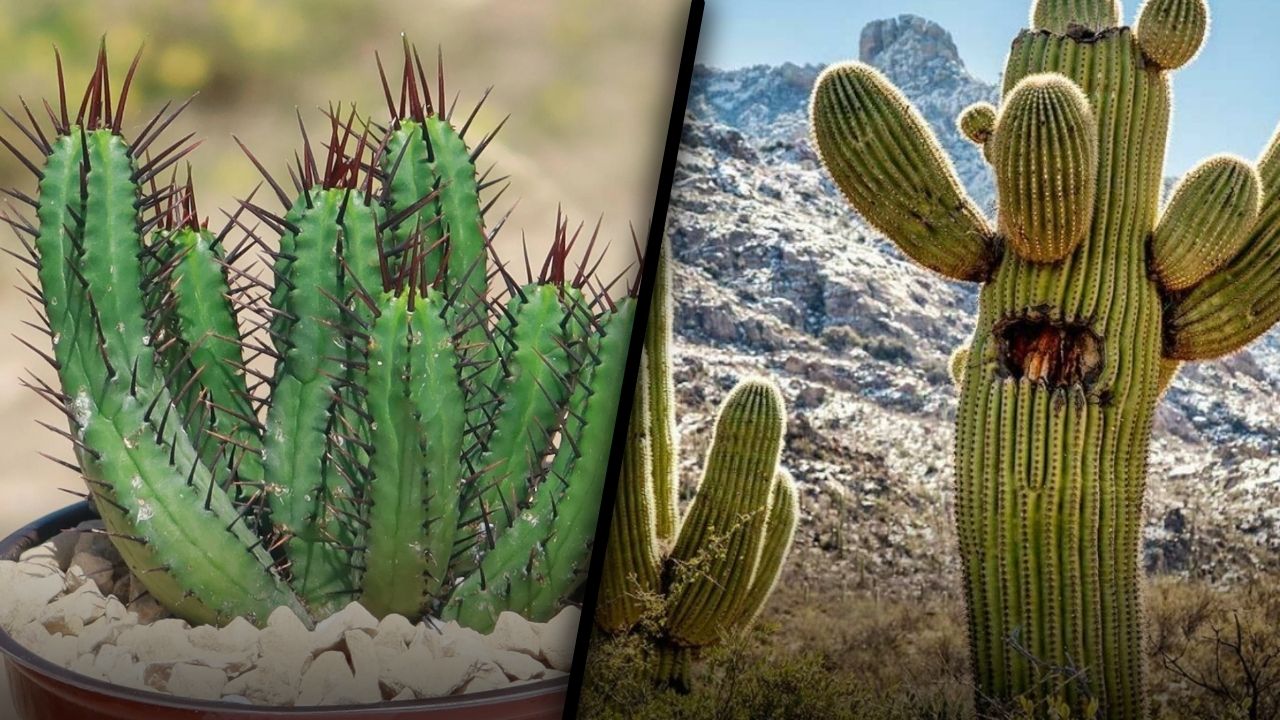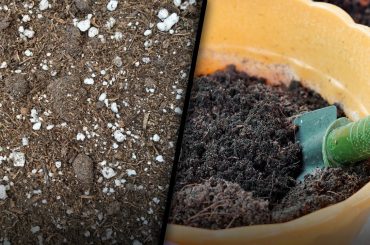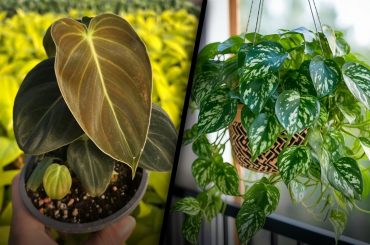It can be difficult to differentiate between euphorbia and cactus in the garden. After you get past the thick leaves and sharp bits, you’ll see that these two plants are quite different. Let’s examine them carefully to see what the differences are.
Key Differences Between Euphorbia vs. Cactus
Both euphorbia and cacti have moisture-retentive foliage and can withstand drought, but they are quite different from one another.
The main differences between Euphorbia plants and others are that they have different leaves, they leak milky sap from broken stems, and they have small flowers in comparison to their overall size. Plants with spines and areoles have no apparent separation between the roots and foliage.
What is a Cactus?
The Cactaceae family of the Caryophyllales order contains the cactus plants (cacti or cactuses plural). The southern areas of North America and South America are home to 127 cacti.
A cactus is a succulent plant, meaning it conserves water within its fleshy body. The Atacama desert is one of the world’s driest regions and is home to many cacti that live in desert environments. Mountain-dwelling epiphytes and mountain-dwellers both grow there.
Kaktos, an ancient Greek word for a spiny plant, is the root of the name cactus.
What Is Euphorbia?
In the Euphorbiaceae family, Euphorbia is a genus of more than 2000 species of plants. From trees to the smallest border filler, Euphorbia can be found as annuals, biennials, or perennials. A variety of spurge plants can be found in most climates except for those in frozen areas and they are among the largest flowering plants in the world.
Ancient Greek physician Euphobos wrote about the effectiveness of Euphorbias as a powerful laxative and described them as native to the Old World, especially Africa.
It is common to confuse euphorbia with cactus. There are a few simple ways to tell the difference between euphorbias from Africa and Madagascar and cacti.

Growing Zones for Euphorbia and Cactus
Euphorbia’s plant range is so wide that there is no single growing zone. The majority of plants can tolerate Zone 9 and above, but some are capable of tolerating Zone 4. Southerly zones can have evergreen plants.
Cacti follow a similar pattern. The majority of them require zones 6 and above, although some can handle Zone 4 cold. Species vary.
Euphorbia vs. Cactus: Foliage Differences
From broken euphorbia stems, milky sap leaks, which is one of the most noticeable differences between euphorbia and cactus. Milky sap isn’t found in cacti. The sap on the tree is highly irritating, so wear gloves if you break a piece off.
It depends on the type of cactus, but many of them have modified leaves that have spines. All emerge from areoles, some of which are soft and woolly. Areoles are only found in cacti and they produce spines as well as flowers. To conserve moisture, they develop in a small, hard form of shoots and branches. All cacti will have areoles, but not all of them will have spines.
A variety of Euphorbia species produce different foliage types, from narrow, linear, lime green foliage to brightly colored rosettes in orange and red. As with some cacti varieties, their foliage tends to be thick and rough.
The thorns on some Euphorbias form a V shape rather than having spikes.
Do All Euphorbias Have Spines?
Spines and thorns are quite different from each other, as you may have wondered. A spine is a leaf, and a thorn is a branch!
A cactus has spines growing from its areoles, while an euphorbia has thorns growing from its stem. Due to the large number of species within each genera, not all species have spines or thorns.
Euphorbia vs. Cactus: Flowers
Insects, bats, and birds pollinate both euphorbia and cactus flowers, but lizards pollinate some euphorbia species in some countries!
Eugenias have small flowers in comparison to their stems and foliage, and they are usually yellow in color, but they can also be red, cream, pink and pale green depending on the variety. During many weeks or even months, their protective bracts surround the actual flowers.
There are three types of seed that mature in Euphorbia flowers: round, pumpkin-shaped, and knobbly.
Contrary to cacti flowers, cacti seeds are smooth spheres or ovals that develop into dazzling jewel colors in waterlily form.
Are Euphorbia vs. Cactus Toxic?
A number of euphorbias and their cultivars are toxic, including pencil cactus (yes, the plant is classified as a euphorbia, I know that sounds odd!) and Crown of Thorns. Pets can suffer from diarrhea, vomiting, breathlessness, or collapse from their milky sap, which was developed to deter wild animals from grazing.
Children playing nearby should always wear gloves and take care because it’s poisonous to humans.
It depends on the species of cacti whether they are toxic or not. There are some that are worse than others, such as prickly pears, even though the majority are relatively harmless when eaten.
The spines of cactus can cause allergic reactions in some people.
Are Euphorbia Related To Cactus?
Cacti and Euphorbia are not related, but succulent varieties of Euphorbia do resemble succulent cacti. Euphorbia is part of the Euphorbiaceae family, whereas succulent cactus is part of the Caryophyllales family. The question is a good one.
How To Grow Euphorbia vs. Cactus
The plant growing requirements vary from species to species, so always check before you purchase!
A well-drained soil and sun are essential to cacti and euphorbia. You should plant them in the most sunny part of your garden since they are drought-tolerant and can withstand a lot of heat.
Grit can be added to the soil to improve drainage, or you can plant them on a slope so rain can run off before the roots get wet.
Providing a stone or gravel surround will help protect them once they have been planted. In addition to providing extra warmth, it also prevents rain or sprinkler splashback on their foliage.
Fertilizing succulents and cacti is very rare. You should use a specific succulent fertilizer if they turn yellow if you feed them. Feeding them often leads to rotten plants.
The cactus plant is often kept as a houseplant. Those who forget to water them love them because they can go for months without watering.
Can You Propagate A Cactus?
Plant propagation is simple for cacti. Start them off by making an Easter cactus, a succulent with multiple stems or segments, if you want to involve them in the process.
-
A segment or section can be snipped off
-
The cut needs to heal on a sunny windowill, so don’t be surprised! Plant cuttings usually need water or soil immediately, whereas this is quite the opposite.
-
Compost gritty cactus in a pot
-
Be sure to push the base part of the healed segment into the soil an inch.
-
Place it on a warm, indirect-lit windowsill and water it well
-
Another segment will grow in a few weeks.
It is possible to propagate barrel-shaped cactuses by splitting the root ball and replanting the halves or quarters.
Cactus cuttings or fully grown cactus shouldn’t be covered with a plastic bag because humidity causes mould and rot. A dry, hot climate is ideal for cactus growth.
Why Is My Euphorbia Not Flowering?
Euphorbias and cacti lack flowers primarily because of insufficient sunlight. Although there are also varieties that are shade-loving, euphorbias love light. Make sure they are in a sunny area.
Is Euphorbia or Cactus Best?
In sun-soaked gardens, both species make attractive ornamental plants, so it’s hard to choose. The sap and seeds of Euphorbia are toxic, so it’s not the best choice if you have pets and children. In contrast, spine-covered cactus plants pose a different set of challenges.





